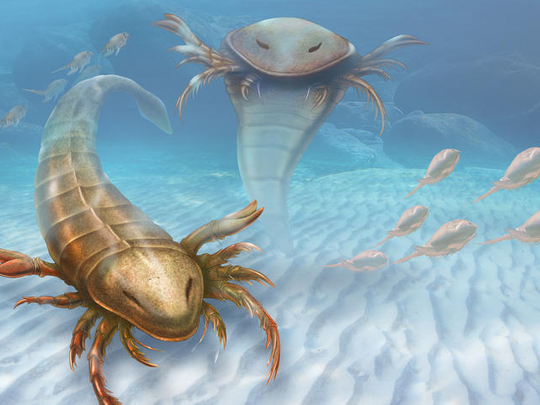
Washington: Scientists have found evidence of a giant scorpion-like animal that roamed the seas hundreds of millions of years before the dinosaurs.
The research team named the newly discovered creature Pentecopterus decorahenis because it looks like early Greek warships known as penteconters. “Decorahenis” is a reference to Decorah, Iowa, near where the fossils were found.
Pentecopterus lived about 450 million years ago. It is the earliest known member of an extinct group of animals known as eurypterids that are related to hermit crabs, spiders and scorpions.
Most eurypterids of that time were relatively small — about 2 inches long — but not this one. Paleontologists said it was a giant that could grow up to 6 feet long.
It had massive spines on its front limbs that it probably used to catch prey. It also had a large paddle-like feature on its rear that helped it swim through the water. Scientists say it used its middle legs to scuttle along the bottom of the sea.
The research team, led by James Lamsdell of Yale University, looked at more than 150 fossil fragments from at least 30 individuals. They describe their findings Monday in the journal BMC Evolutionary Biology.
The fossilised bits were not bones; Pentecopterus is not a vertebrate and it had no bones. Rather, the researchers examined unusually well-preserved pieces of the hard exoskeleton that these animals would have shed several times over their lifetime. If you’ve ever seen a cicada shell stuck on a tree, you know the amazing detail that an exoskeleton can reveal.
“We could see how the legs are articulated with each other, and how it would have moved,” Lamsdell said. “We see lots of insertion points for hairs, which can tell us how it saw its outside environment.”
Most of the specimens were collected from a site in northeastern Iowa known as the Winneshiek Shale. The site is within an ancient meteorite impact crater and was mostly submerged by the Upper Iowa River.
A excavation in 2010 revealed more than 5,000 fossil specimens from the Ordovician time period, which spanned from about 485 to 443 million years ago. In addition to the Pentecopterus fossils, scientists have found fossils of arthropods, possible jawless fish and eel-like conodonts in addition to algae and plant material.
To accurately describe Pentecopterus, Lamsdell peeled these ancient exoskeletons off pieces of rock.
“We were very lucky that the rock will turn back to mud when you get it wet, so we were able to remove the fossil with a paintbrush and water,” Lamsdell said.
“The hardest part was keeping the exoskeletons intact,” he said. “They are paper thin, but thankfully the only damage was to my nerves, rather than the specimens.”












